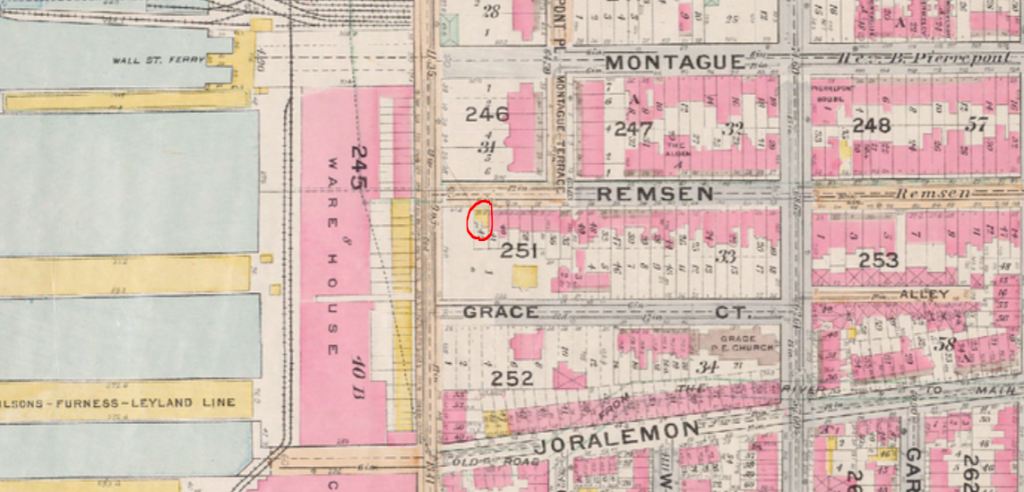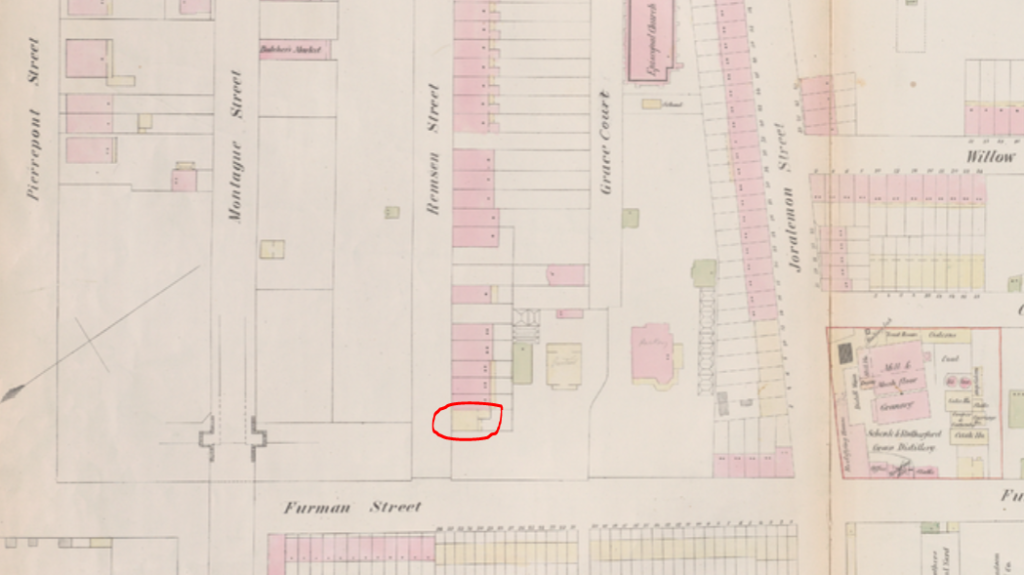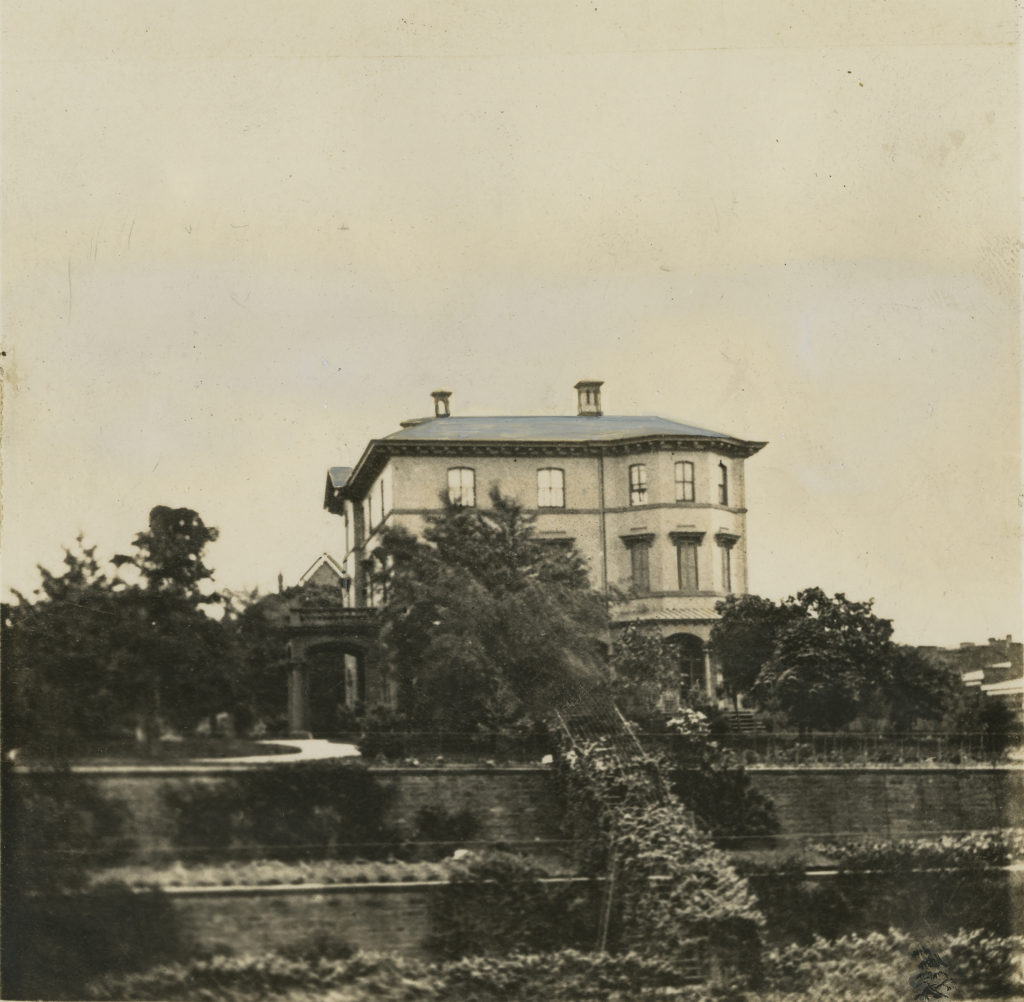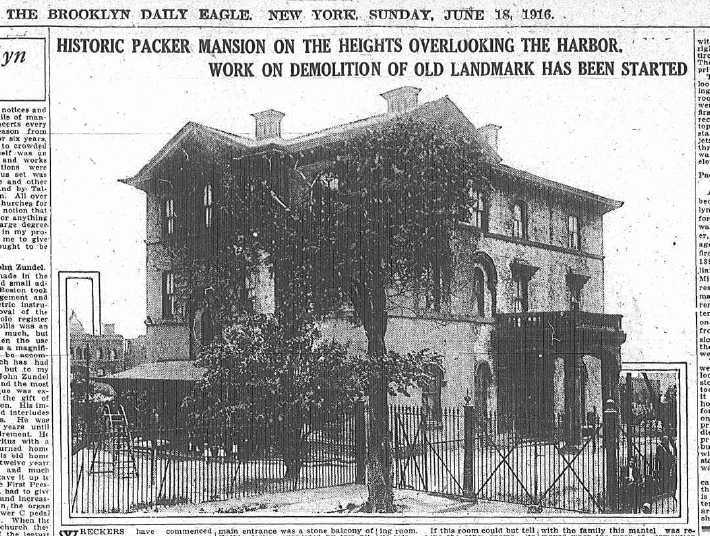
Many people ask me how I discover my stories. Most of my stories start off with a small article in an old newspaper. I then spend several hours or more researching the history behind the location where the animal lived or the history of the person who owned the animal. Sometimes my research leads to a dead end. Other times I hit the jackpot and discover tons of great history and photos to go along with it. The following story of Harry Cat of Remsen Street is what I call a jackpot story.
Harry Cat was a large and lazy solid white cat. He lived with a woman named Mrs. Lester and his twin feline brothers, Tom and Dick, in a wood frame boarding house at 8 Remsen Street. The house was on a bluff overlooking the East River, a row of frame cottages, and the piers and warehouses along Furman Street.
According to several maps from 1855 to 1898, Tom, Dick, and Harry Cat’s house at 8 Remsen Street was the only frame house—and only one of two frame structures in total—on the block. (The other frame structure was the large John Hill Prentice mansion.)
So, it’s a good thing large and lazy Harry was alert and on the job on December 10, 1899.

Until that fateful day, Harry was never the favorite of the three brother cats. In fact, he was reportedly “so big and fat that its owners never thought it would rise to the occasion of becoming a hero.” Instead of playing with his brothers, Harry preferred to coil up on the bearskin rug in front of the dining room fireplace.
But on the morning of December 10, while he was lounging in the smoking room of his home, one of the male boarders carelessly threw a lit match. Instead of falling into the cuspidor, it landed on the bottom folds of a lace curtain. In just seconds, the entire curtain was on fire.
Before any of the young men in the room were able to reach the curtain, Harry sprung from the rug and pounced onto the curtain, pulling it down. The men were able to toss the curtain out the window, but poor Harry sustained burns, and his beautiful white fur was singed from his body.
Harry was immediately placed under the care of a veterinarian, who told Mrs. Lester that while he was expected to recover, it would be a long time before he returned to his normal condition. Mrs. Lester gave Harry the best bed in the house for his recovery, and from that day on, the cat was loved and petted just as much—if not more—than his brothers.

The Donkey Boiler Explosion
Two months after Harry Cat saved the house at 8 Remsen Street from burning down, the house was almost destroyed again when a donkey boiler exploded. The boiler was in a ship docked at Pier 16 of the Prentice Stores warehouses at the foot of Remsen Street.
The explosion shook the neighborhood and shattered numerous windows. One eight-hundred-pound piece of iron dropped into the yard of the frame cottage at 290 1/2 Furman Street. It lodged into the ground just as Mrs. Thomas Brennan was carrying a wash tub into the yard where some children had been playing.
Another piece of the iron boiler shot through the air about one thousand feet, wrecking a window and plowing into the western wall at Harry Cat’s house.
Upon hearing the loud noise and feeling the house tremble, Miss Rose Jackson, a servant for the house, ran up to the third floor to see what had happened. She found a large piece of iron, about six feet long, sticking out from the outer wall. The room was completely wrecked indoors; a bow window and numerous weatherboards on the outside of the house were also damaged.
Miraculously, no humans, felines, or otherwise were injured in the event.
The History of 8 Remsen Street
The house at 8 Remsen Street was located on the John Hill Prentice Estate. The small frame home–and the larger frame mansion–have an interesting history.
In the late 1890s, when the story of Harry Cat takes place, the small house was a boarding house operated by Mrs. Eleanor Shackelford Davis.
Mrs. Davis was the ex-wife of Mr. Wesley Reid Davis, an art dealer and former pastor at the Reformed Church in Brooklyn Heights. The daughter of the late Judge Shackleford of Virginia, she was described as “a woman of great ability.”
In addition to running the boarding house, Mrs. Davis was a practicing attorney, having passed her bar examination in 1896. Reportedly she used her legal skills to fight her son in court when he married a woman who did not meet her approval.
According to the Brooklyn Daily Eagle, the Prentice mansion was built in 1835 by Charles Hoyt, a merchant and real estate developer. It was originally located in the center of Remsen Street near Hicks Street, adjacent to the future site of the circa 1847 Grace Episcopal Church.
When John Hill Prentice purchased the property, he moved the mansion and the little frame house to a bluff overlooking the East River.

The Prentice Mansion
In 1840, John Hill Prentice (1803-1881) moved to Brooklyn and purchased a tract of land on the old Joris Remsen Farm. The large lot was bounded by Remsen, Joralemon, and Hicks streets and the East River.
John had been a leading fur merchant in Albany with his partner William Satterlee Packer. In Brooklyn, he established Prentice’s Stores, a series of warehouses located on the piers at the foot of Remsen Street. During his lifetime, he served as president of the Nassau Water Works, treasurer of the Packer Collegiate Institute and the East River Bridge (Brooklyn Bridge), and trustee of the Brooklyn Savings Bank and the Green-wood Cemetery.
When they first arrived in Brooklyn, John and his wife, Sarah Davis, and five of their 18 children (Anna, John, Marian, Fowler, and Ezra) moved into the Hoyt home. Their first two children had died shortly after birth in 1832 and 1833. Their last child was born when Sarah was 43 years old in 1852.
I have no idea where John found the time to create such a large family, which he called the Prentice Cavalry.

In 1850, John Prentice moved the large frame Hoyt house to the foot of Grace Court. He added a level for the servants over the foundation cellar, added a music room on the first floor with dressing rooms above, and enclosed the back piazza.
The one-block street, which he named Grace Court in honor of the new Grace Church, was opened through to his house. John also sold his land on Remsen Street for residences, with one restriction: the owners had to establish rear gardens abutting Grace Court.

The Prentice mansion at 1 Grace Court was described as “A large, square, wooden house, with greenhouses and stables and gardens with grapevines sloping over the hill.”
To the right of the house was a coach house and stables behind that. A paved walkway led to the hot and cold greenhouses where strawberries, Muscat grapes, and mushrooms were cultivated.
Three 14-foot-wide terraces with sustaining stone walls featured fruit trees of all kinds, including peach, pear, apricots, figs, and nectarines. Many of the Prentice family pets, including chickens, ran freely among the trees.

From these terraces, a steep wall surmounted by high iron railings descended to Furman Street, where a row of frame cottages was built. Below was the Prentice Stores warehouses and docks adjacent to the New York and Brooklyn Wall Street Ferry.
One of the most popular features of the Prentice estate was the fountain circle on Grace Court, which John erected after the introduction of water in Brooklyn by the Nassau Water Works, of which John was president. The children especially loved the constant flowing water and watching the goldfish in the fountain. Every once a while one child would push another child into the fountain when he she leaned over too far to watch the fish.

John Prentice retired in 1860 and died twenty years later in March 1881. His widow died in the home in 1893.
The Prentice mansion was occupied for many years by John’s younger brother, James Prentice, and his wife Eloise. But in November 1904, W.S. Prentice announced that the old Prentice mansion was in a dangerous condition and would need to come down.

The Packer Mansion
Directly across from the Prentice mansion was the Packer mansion at 2 Grace Court, which was built in 1850 by John Prentice’s former partner, William Satterlee Packer. William’s wife, Harriet L. Packer, had been the live-in governess for the Prentice children when she first saw a portrait of Packer on the wall and became immediately smitten with the older man.
The couple married in 1842 and had three children.

Sadly, William died shortly after the grand home was built, but Harriet remained living there and leading many philanthropic activities for many years. Mrs. Packer founded the Packer Collegiate Institute on Joralemon Street in 1854 and named it in honor of her late husband.
In 1889, the Packer mansion was described as follows: “A large, narrow, brown, brick mansion, with gable roof, grounds, greenhouses, grape arbors, stable, porter’s lodge, etc.” In addition to the stables, which housed many fine horses, the property had a cow pasture occupied by the family’s pet raccoons and a reportedly vicious cow.
As it was noted of the Prentice and Packer mansion in the Brooklyn Daily Eagle in 1900, “These two houses, by their position, command the most perfect view of the harbor of all the old residences on Brooklyn Heights.”

The Demise of the Prentice and Packer Mansions
In April 1905, Bryan L. Kennelly, auctioneer, sold the Prentice estate. The property was listed as a three-story and basement brick and frame building at 8 Remsen Street; a three-story attic and basement brick and frame mansion at 1 Grace Court; and a stable and coachman’s house.

The purchaser was S.R. Haxton, who bought the property as an investment for $75,000. The mansion was torn down around 1909, although the house at 8 Remsen Street was still standing as late as 1911.

In 1925, a six-story apartment building was constructed on the site of the former Prentice mansion. This building featured elevators and six- and eight-room apartments, each with three baths. Today, the 24-unit co-op offers a rooftop terrace with magnificent water views.

Members of the Packer family occupied their house until about 1910. At once point, the home was purchased with plans for building a 16-story apartment building on the site. The deal fell through after an agreement with the Grace Episcopal Church was discovered, which required Grace Court to be kept open for air space.
For several years, the Packer site was set aside for recreation and tennis courts.

Sometime around 1923, the site was purchased by Thomas H. Wheeler, former president of the Standard Oil Company of New Jersey. The original plans called for a group of small dwellings with an interior garden court or playground. But with large apartment buildings going up on the opposite side of the street, the plans were changed.
According to the revised plans, the six-story Gothic-style building featured three wings, 160 apartments of three to seven rooms, and four-passenger elevators. At this time, Grace Court was opened and extended to the Furman Street wall, which is 60 feet above the water line. The new building was the largest apartment house in Brooklyn at the time.
The six-building apartment building currently at 8 Remsen Street was built some time around 1911.


June 9, 7-8 PM (EST): The Cat Men of Gotham: Tales of Feline Friendships in Old New York
Scotch Plains Library
To Register: https://www.scotlib.org/event/the-cat-men-of-gotham-tales-of-feline-friendship-in-old-new-york/
July 14, 7-8 PM (EST): The Seafaring Cats of Gotham: Tales of Nautical Felines of Old New York
Woodbridge Library
Click here to register.



